
Cultivate a compassionate heart through Japanese culture
Tea culture is deeply rooted in Japanese people, but one should remember that tea ceremony was originally a means for entertaining guests and thus allowing them to deepen the bonds of friendship through communication. In France, inviting someone to your home for a glass of champagne would be the equivalent of a tea ceremony in Japan. Chakaiseki Akiyoshi is the place to experience this traditional Japanese ceremony.
By studying tea ceremony for 20 years, I was able to deepen my understanding of the origins of Japanese cuisine. In one word you could refer to it as culture, but it is the spirit of caring for others that is deep-rooted within Japanese cuisine. This is what I want to share. The spirit of wanting to serve and making the other person happy, and the feeling of gratitude that springs from customers when it is conveyed. First of all, I would like to do my best so that both the host and the guest can be satisfied. I believe it is my mission to build such heartfelt relationships all over the world, and Japanese cuisine is the gateway to accomplish that.



Host Akiyoshi Yuichiro
Born in 1984 in Iizuka City, Fukuoka Prefecture, Japan. Trained for 10 years at Hyotei restaurant, in Kyoto. Later, he became the head chef at the OECD ambassador`s official residence in Paris, where he served Japanese cuisine for 3 years. After returning to Japan, he opened a Japanese restaurant at AIC Akitsushima, Kyoto. Moreover, he worked as head chef at a high-class Japanese ryokan (traditional Japanese inn) and travelled all over Japan as an itinerant chef. During this time, he established Wabi Co., founded Tanrei Ramen Meikyô Shisui in Fukuoka, Japan. After the Coronavirus pandemic, he opened Chakaiseki Akiyoshi in Paris, France.

What is Chakaiseki?
Chakaiseki refers to a type of dish served during tea ceremony and it is part of kaiseki cuisine (kaiseki ryori). The roots of the word “Kaiseki” can be found in the Zen tradition. Zen monks in training were allowed to eat only one meal a day. During the harsh winter training, they endured the cold and hunger by warming a stone, wrapping it in a cloth, and placing it in their bosom or on the stomach. This stone is called Onjaku or Yakuseki, and the name “Kaiseki” it is said to have come from the act of holding these stones (seki) in the bosom (kai).
Later, in the Zen-influenced tea ceremony, light meals served during the tea ceremony came to be called “Kaiseki.” It seems that it was meant as a way to not stay hunger by warming the stomach using Onjaku, just like the training monks. Because drinking Koicha (exceptionally dark, thick matcha), on an empty stomach, is too stimulating and bitter, you will not be able to fully enjoy its original taste. Therefore, kaiseki dishes are also served with that purpose in mind: to enjoy the taste of Koicha.





It is said that kaiseki meals began to be served at tea ceremonies from the Muromachi period (1336 -1573). The origins and the protocol for Kaiseki cuisine go back to Azuchi-Momoyama period (1573-1603) and to Buddhist tea master Sen-no-Rikyu, before establishing its formal etiquette at the end of the Edo period (1603-1867).
Kaiseki cuisine, which is incorporated into tea ceremonies, uses seasonal products and makes the most out of natural flavour of the ingredients. Its aim and essence reside in the sincere hospitality of customers.


59 Rue Letellier, 75015 Paris FRANCE
E-mail: wabijaponparis@gmail.com



